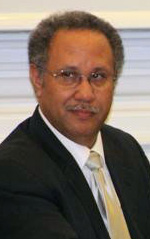Developing the Next Generation of Followers at USAID
We need to better understand followership—not just because it essentially complements leadership, but for its own specific qualities.
BY JOSÉ M. GARZÓN
Several years ago, I interviewed a Presidential Management Fellow candidate who, flush with enthusiasm, told me how much she wanted to lead people. She passionately described how, as a Peace Corps Volunteer, she had led the effort to bring water to villages in Honduras, overcoming all sorts of obstacles, and concluded with a rousing plea: “I want to lead! I want to lead!”
“Wonderful,” I replied. “But would you like to follow? We really need followers right now.”
I can be such a buzzkill sometimes.
But I was trying to make a serious point. The U.S. government and the private sector devote enormous energy and resources to the subject of leadership. The Federal Executive Institute is dedicated to “helping executives perform effectively as the top leaders.” The stated purpose of the National Defense University is “Educating, Developing and Inspiring National Security Leaders.”
Leadership is also among the promotion precepts for FSOs, and everyone is rated against that precept. We take for granted that, with greater experience, every employee should assume greater leadership responsibilities. And why not? Who wants to become a follower? To be called a follower is nearly a professional insult: supposedly, followers don’t make things happen, they don’t make a difference. No inspirational poster ever says “You, too, can be a follower!”
But with all this leadership, is anyone following? Who is selected, trained or rewarded for following? And without followers, is anyone actually leading? This is not a trivial question, as followership cannot be assumed.
Many would-be leaders who have charged up a hill have found themselves in a lonely place. Part of the problem is that we tend to confuse leadership with holding a leadership position. But all of us know people who are put in such jobs who are not leaders and would contribute much more by holding what I call a followership position.
Moreover, not everyone in the Foreign Service wants to be a leader, but may feel compelled to contort themselves to fit that pigeonhole—an unfortunate waste of talent. Even if we accept the narrow bureaucratic concept of leadership, everyone in a leadership position is still in a position of followership to someone else. Indeed, we spend most of our professional time following, not leading.
So we ignore followership at our peril. We need to better understand it, not simply because it essentially complements leadership. As I will demonstrate, followership is also the critical skill needed for the most challenging Foreign Service assignments.
Defining Followers
What kind of followers are we talking about here? Sheep? Paper shufflers? Robots? Absolutely not! This is the critical point: the difference between good and bad followership. Good followers work both independently and collaboratively. They need minimal supervision. They take initiative; they create. Most importantly, they display courage. They know how and when to speak up, give bad news, make suggestions and dissent when needed.
In 1988, management scientist Robert Kelley rebelled against the leadership culture with an article, “In Praise of Followers.” In his 1992 book, The Power of Followership, Kelley posits a model that groups followers into four categories based on their level of independence, critical thinking, and activity or passivity.
Maybe the U.S. government isn’t yet ready to embrace the Zappos model, but the idea of followership still deserves careful consideration.
A dependent and passive follower is one who relies on leaders to think for them and who requires close direction. Kelley calls them “sheep.” The active version of this (active, but still dependent) is the conformist follower, or “yes person.” These two groups are usually associated with the term “follower.” The third category is the alienated follower. These are the individuals who are independent, but passive. On a good day, they are the skeptics in our midst; on a bad one, they are called cynics. But in a bureaucracy, they are the ultimate survivors, because they do not oppose. They follow and grumble.
Kelley’s ideal is the independent, active follower, which he calls the exemplary or “star” follower. Exemplary followers possess four qualities: 1) they manage themselves well; 2) they are committed to the organization and its goals; 3) they build their competencies; and 4) they are “courageous, honest and credible.” In Foreign Service language, they are constructive dissenters when the situation calls for it; otherwise, they are just straight-shooters. This goes beyond “managing up,” which refers to one’s relationship with a superior. Followership, by contrast, requires commitment to the organization’s broader values and goals in the absence of clear direction, or when specific directions from a supervisor conflict with those larger values and goals.
Kelley goes on to make another startling assertion based on his research: Self-managed teams work best. Too many leaders can lead to chaos, but the absence of leaders often produces excellent results—provided the team has the right members, who are guided by the mission, not other persons.
The concept of followership didn’t die with the 1990s. It has recently found a new expression in literature (e.g., Reinventing Organizations by Frederic Laloux) and management (e.g., the holacracy system embraced by the online shoe store Zappos, which recently eliminated its middle management in favor of “self-organization”). Maybe the U.S. government isn’t yet ready to embrace the Zappos model, but the idea of followership still deserves careful consideration.
Followership and USAID’s Mission
The concept of followership is relevant to all organizations and sectors, but it matters especially in the field of international development and is therefore of particular interest to members of the Foreign Service at USAID.
Consider where the field stands today. Since 1990, the world has made dramatic strides in reducing poverty, improving health, reducing violent conflict and expanding democracy. But about 50 to 60 states are considered “fragile.” These are societies with low levels of legitimacy and effectiveness, and high levels of instability and violence. While different agencies maintain their own lists, using different methodologies, they tend to agree that places such as Afghanistan, the Central African Republic, Haiti, Somalia and Yemen are highly fragile and unstable, with high levels of poverty. In addition, many transnational problems, from migration and disease to terrorism, find their breeding grounds in these fragile states. From the standpoint of development, these countries have been largely left out of the progress of the past three decades, or earlier progress has been violently reversed. While these are not the only places that demand our attention as development professionals, they certainly will consume much of it.
Yet Foreign Service jobs in such difficult, often dangerous places are usually the hardest to fill. Some, like Afghanistan and Iraq, are unaccompanied posts (Critical Priority Countries in USAID parlance). They present problems that do not fit neatly within any sector. Instead, they require the ability to work across sectoral and agency boundaries in novel and creative ways. Above all, they require courage: not only bravery in the face of real physical risks, but the willingness to send bad news up the chain of command and to constructively dissent when necessary. Since fragile states abound with policy and program failures and contradictions, they generate plenty of bad news to report.
For all these reasons, Foreign Service work in these states requires a certain kind of professional: one who is able and willing to work independently, deeply commit to a mission, continuously build new competencies (especially by engaging with different professionals or by developing new cultural and linguistic skills), go where the action is, speak truth to power and be credible to all parties.
The Ideal Follower
That person is the exemplary follower. Such individuals and their teams need more freedom of action, not less. But the natural reflex of bureaucracy is to go in the opposite direction. What tends to happen, especially in the CPCs, is that the U.S. political leadership sends more leaders and more money—but then requires those employees and managers to spend most of their time accounting for, well, their time. This was particularly true of Afghanistan during my tour from 2008 to 2009 there as head of the Democracy and Governance Office. The organizational chart became an inverted pyramid as multiple ambassadors and coordinators, along with the Office of the Special Inspector General for Afghanistan Reconstruction and a constant train of congressional delegations, all watched over project managers who had little mobility or authority.
A particularly unfortunate side effect of heavy oversight is that mere “staff” are discouraged from revealing policies that are not working or counterparts who are abusive and corrupt. I can attest from my work in Latin America that reporting human rights abuses by security forces is often not welcome. Under these circumstances, the exemplary follower may be unfairly viewed as “not a team player,” when this kind of employee is the one who can actually build U.S. credibility.
Exemplary followers, and their teams, need more freedom of action, not less.
The Foreign Service’s traditional methods of selecting, developing, promoting and rewarding staff are designed for relatively stable contexts. One gradually assumes greater responsibilities and becomes a leader, or at least moves toward that goal. But complex, unpredictable environments, such as fragile states, challenge traditional management paradigms. These environments require quick, creative responses and the sorting out of competing objectives. They demand a higher level of independence, the ability to collaborate and creativity. Loyalty to the mission becomes more important than mere compliance with procedures and directives.
In some cases, as occurred with provincial reconstruction teams in Iraq and Afghanistan, an employee is attached to a special unit away from the capital and must work independently of the “mother ship.” Even in the embassy or USAID mission, employees have to negotiate their way through a tangled web of interagency, multisectoral and multi-institutional interests without the benefit of a proven textbook. A good example of this is rehabilitation of youth soldiers and gang members, where interventions are legal, social, psychological and economic. Trial, error, rapid learning and retrial slowly show the way forward, and competing priorities (e.g., supporting a new government vs. protecting human rights) need to be sorted out in practice. A professional who simply manages up or follows direction will not provide the type of energy or creativity to such a complex task.
Restoring the Balance
The Foreign Service already has many exemplary followers, but they do not receive the same encouragement and opportunities to excel in that role as leaders receive in theirs. So how should USAID and other foreign affairs agencies go about restoring balance between these two sides of the same coin?
Down the road, we should consider establishing a School of Followership Studies at the Foreign Service Institute, which already has a very active School of Leadership and Management. Even Foreign Service employees who are wholly committed to becoming organizational leaders could benefit from a few courses on followership. But that will obviously take significant time and resources. In the meantime, here are a few suggestions to nurture the next generation of exemplary followers.
One approach could be for USAID to create self-managed teams in the field, charged with proposing and implementing new solutions to a thorny development problem, such as insecurity or natural disasters. These teams would have the freedom to experiment, make program adjustments and carry out frequent, informal evaluations.
Another application of the followership principle lies in reworking the selection, training and development of new Foreign Service officers, something I think will resonate with millennials. We should identify and nurture the qualities that will be needed for the messy world they will enter, such as independence, creativity, flexibility, the ability to work unsupervised and, above all, courage. Why not give stronger weight to these qualities in the Foreign Service promotion precepts, and evaluate performance accordingly?
Finally, as I’ve already noted, a key indicator of exemplary followership is the practice of constructive dissent. This has an illustrious tradition in the Foreign Service, and AFSA rightfully recognizes it. Yet while the State Department Foreign Service promotion precepts do include a section on constructive dissent, that is absent from the USAID precepts.
Not surprisingly, few USAID FSOs write dissenting cables or memos, and few have received AFSA’s own awards for constructive dissent. USAID’s own Direct Channel—which, like the State Dissent Channel, is intended to allow FSOs to bring concerns and critical information to the attention of senior agency leadership—has gone largely unused. That is particularly discouraging for an organization that supports democracy and prides itself on an open and democratic internal culture. Perhaps constructive dissent is not part of the USAID organizational culture, or perhaps USAID FSOs do not feel the need to formally dissent. But I suspect it is also because USAID FSOs are feeling especially vulnerable because they serve in a non-Cabinet agency that faces heavy oversight. As USAID focuses more on fragile states where poverty and instability is most difficult to overcome, we will need to see more constructive dissenters and sharers of honest information.
Ultimately, the idea of followership is about turning the bureaucracy on its head and shaking it a bit before putting it back on its feet. We hear a lot about “innovation.” Innovation is a wonderful idea, but it needs to transform from a buzzword to natural habits and practices. To truly innovate requires an organizational culture where leadership is enhanced by followership. If we follow, we shall also lead.
Read More...
- “Tips from the Belly of the Python”, FSJ May, 2015
- “Diplomatic Training: New Trends”, FSJ September, 2016
- “Why Followership is More Important Than Leadership”, Forbes, January 2016
- “Followership: The Other Side of Leadership”, Ivey Business Journal, Sept/Oct 2013
- “First, Let’s Get Rid of All the Bosses”, New Republic October, 2015









